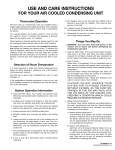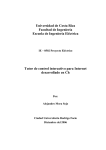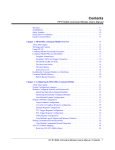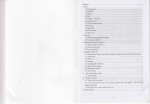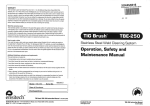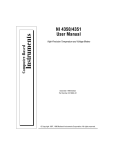Download Trouble Shooting Techniques - Iowa Antique Radio Club and
Transcript
TABLE OF C O N T E N T S Page No . INTRODUCTION ............................................................. 1 ........................................................... 1 ............................................................ 2 BASIC PROCEDURE TEST EQUIPMENT .................................................. 2 ..................................................... 2 ............................................................ 2 ....................................... 2 ...................................... 2 ............................ 3 Vacuum-Tube Voltmeter R-F Signal Generator POWER SUPPLIES General Function of the Power Supply Localizing Trouble to the Power Supply Isolating and Locating Trouble in the Power Supply AUDIO CIRCUITS ............................................................ 5 General Function of the Audio Circuits . . . . . . . . . . . . . . . . . . . . . . . . . . . . . . . . . . . . . . . 5 Localizing Trouble to the Audio Circuits . . . . . . . . . . . . . . . . . . . . . . . . . . . . . . . . . . . . . . 5 Isolating and Locating Trouble in the Audio Circuits ........................... 5 ............................................................... General Function of the I-F Circuits . . . . . . . . . . . . . . . . . . . . . . . . . . . . . . . . . . . . . . . . . . 8 ......................................... 8 I-F CIRCUITS Localizing Trouble to the I-F Circuits Isolating and Locating Trouble in the I-F Circuits . . . . . . . . . . . . . . . . . . . . . . . . . . . . . . . 8 8 CONVERTER (OSCILLATOR AND MIXER) CIRCUITS . . . . . . . . . . . . . . . . . . . . . . . . . . . . . . . . . . . 9 General Function of the Converter Circuits . . . . . . . . . . . . . . . . . . . . . . . . . . . . . . . . . . . . 9 Localizing Trouble to the Converter Circuits . . . . . . . . . . . . . . . . . . . . . . . . . . . . . . . . . . . . 9 ........................ 10 Isolating and Locating Trouble in the Converter Circuits ...................................................... 11 ................................. 11 Localizing Trouble to the R-F Circuits . . . . . . . . . . . . . . . . . . . . . . . . . . . . . . . . . . . . . . . . . 11 lsolating and Locating Trouble in the R-F Circuits . . . . . . . . . . . . . . . . . . . . . . . . . . . . . . . 11 R-F AMPLIFIER CIRCUITS General Function of the R-F Amplifier Circuits . . Copyright, 1952 PHlLCO CORPORATION C TROUBLE-SHOOTING TECHNIQUES INTRODUCTION This handbook is intended to familiarize the technician with a methodical procedure for trouble-shooting radio receivers primarily, but the principles can also be applied to other types of electronic equipment. This method, which is simplified and easy to use, results in faster, more efficient servicing. Personnel with limited experience will find that it enables them to trouble-shoot equipment with a minimum of time and. labor. BASIC PROCEDURE In order to simplify the use of schematic diagrams, certain test points have been specially marked with letter symbols. The basic method of trouble shooting has three principal subdivisions: 1. General LOCALIZATION of trouble to a single SECTION of the radio receiver, by making checks a t certain designated test points. 2. ISOLATION of the faulty CIRCUIT within chat section by making checks at other test points designated in the procedure. 3. LOCATION of the defective PART within t h a t circuit by making simple voltage and resistance measurements, and in some cases, part substitutions. The functional sections into which the receiver is divided for trouble shooting are: 1. Power supply. 2. Audio circuits. 3. I-F, detector, and a-v-ccircuits. 4. R-Fand converter circuits. Analysis by functional sections enables the technician to apply this knowledge to any particular radio. A typical block diagram of a superheterodyne radio receiver is shown in figure 1. NOTE: The trouble-shooting procedure in this manual i s bared on the assumption that the various sections of the radio ore checked in the order given, and that when a defective component is found, the trouble is cleored before proceeding. ANTENNA SPEAKER AUDIO OSCILLATOR POWER SUPPLY TP2-977 Figure I . Block D i a g r a m of Typical Superheterodyne Receiver TROUBLE-SHOOTING TECHNIQUES POWER SUPPLIES TEST EQUIPMENT For efficient radio servicing it is important that the technician be equipped with the necessary test equip ment. The following equipment is desirable: VACUUM-TUBE VOLTMETER A good vacuum-tube voltmeter, such as the Philco Electronic Circuit Master Model 7001, is capable of making all the measurements required in the everyday work of the serviceman. These include: D-C voltage ranges to 1000 volts; current ranges to 100 m a and 30 amp. A-C voltage ranges to 1000 volts (60 to 400 cycles); current ranges to 10 amp. Resistance ranges to 1000 megohms. Capacitance ranges to 50,000 ppf and 500 pf. GENERAL FUNCTION OF THE POWER SUPPLY The power supply in a radio receiver performs the following functions: 1. Supplies the proper filament voltage to all sections. 2. Supplies the proper B-plus voltage to all sections. 3. Supplies bias voltage to some sect ions. 4. Provides adequate filtering when the source of supply is other than pure direct current supplied by a battery. LOCALIZING TROUBLE TO THE POWER SUPPLY WARNING If a vacuum-tube voltmeter is not available, a good volt-ohm-milliammeter such as the Philco Circuit Tester Model 7005, may be used for most of these measurements. When moking msistonce measurements, or when trouble R-F SIGNAL GENERATOR sistor, and with the hand well insulated, short-circuit The &plus voltoge is high enough to cause injury. When making voltoge measurements, be coreful not to touch live terminals. shooting, turn off the power. Using o low-volue re- When trouble-shooting r-f, i-f, and audio circuits, a good r-f signal generator, such as Philco Model 7070, is required. A generator of this type is capable of radio-frequency coverage from 100 kc. to 110 mc. (six bands), with a 400-cycle modulating frequency also available. the filter copociton. Failure to do this may result in damoge to the test equipment. 1. A resistance measurement between B plus and B minus should be made at the output of the filter network. The resistance measured will vary with each radio, and should be in accordance with the manufac- TP2-978 Figure 2. A-C Power Supply TROUBLE-SHOOTING TECHNIQUES turer's specifications. Normally this resistance will be approximately that of the bleeder resistor, or in circuits that do not have a bleeder resistor, the resistance will be approximately that of a good output filter capacitor. If the resistance is too low, check for shorts before turning the set on. 2. When the power is turned on, allow the tubes to warm up for several minutes. Listen and look for arcing, crackling noises, or unusual odors emanating from the radio. If any of these conditions exist, turn off the radio immediately and seek out the parts causing these noises or odors. If none of the above symptoms appear, check the B-plus voltage at the output of the power supply. This is done to determine whether the power supply is a source'of trouble. An abnormal voitage reading at this point (as compared to the value given in the service manual for that model) indicates that there is trouble within the power supply. The next step in the trouble-shooting procedure consists of isolating the trouble to a particular circuit in the power supply. ISOLATING AND LOCATING TROUBLE IN 'THE POWER SUPPLY A-C Power Supplies A typical a-c power supply is shown in figure 2. With this type of power supply the a-c line voltage is connected (through the on-off switch) to the primary of the power transformer (TI). The high voltage output of the power transformer is connected to the plates of the rectifier tube. A pulsating d.c. at the output (cathode) of the rectifier tube is then connected to the filter network. Troubles localized to the power supply can therefore be isolated by a logical sequence of voltage and resistance checks, starting at the output of the filter network and working back to the rectifier tube and the power transformer. As shown in figure 2, the filter choke ( L l ) is connected to one side of the rectifier tube filament; this connection is usually made at the rectifier tube socket. The other side of L1 connects to the B-plus terminal of the power-supply output (test point B). Therefore, locating this lead in the chassis and tracing it from L1 to a terminal will locate the B-plus point in the chassis. CAUTION To prevent damage, always use the highest range of the voltmeter when measuring unknown voltage values. After the approximate value is determined, disconnect the meter, select a suitable range, and then reconnect the meter. Most troubles in power supplies are caused by a breakdown of parts in the filter circuits. Inasmuch as the filter circuits are practically alike for all power supplies operated on a.c., the procedure for isolating and locating trouble described here should be followed. T o isolate trouble in an a-c power supply, begin by measuring the voltage from test point B to B minus (test point A). Low voltage at this test point is usually the result of a leaky output filter capacitor (C4), a defective bleeder resistor ( R l ) , or a high-resistance filter choke (Ll). If there is no voltage between test point B and B minus (test point A) look for a shofted filter capacitor (C4), an open filter choke (Ll) or a defective bleeder resistor (Rl). Continuing through the circuit, measure the voltage between test point C and B minus (test point A). Low voltage here indicates a leaky filter capacitor (C3) or a defective rectifier tube. Absence of voltage at this test point is the result of a defective rectifier tube or a shorted filter capacitor (C3). The voltage between test point D and test point E shodld equal the full, a-c, high-voltage output of the power transformer (TI). Low voltage between test points D and E could be caused by a low-resistance (partially shorted) secondary winding or low a-c line voltage. Zero voltage between test points D and E indicates an open secondary winding. Check for a high resistance or open winding between test points D or E and B minus (test point A); approximately one half (depending on the location of the tap), the full a-c, rated, output voltage of the power transformer should be indicated. If a' continuity check shows a normal indication for all secondary windings, check for a highresistance primary, an open primary, or a shorted line by-pass capacitor (C1 or C2). WARNING The voltage stored in filter capacitors deer r-f c!v:cy: leak off when the power supply is disconnected from the supply line. To avoid shock, short-circuit all capacitors with a low-value resistor before handling components of power supply. Avoid personal contact with the live terminals. A-C/D-C Power Supplies A typical a-c/d-c power supply is shown in figure 3. The a-c line voltage is connected directly to the radio tubes through the on-off switch, S1. The tube filaments, connected in series, drop the line voltage proportionally, and all tubes have the same filament-current rating. The B-voltage circuit uses one side of the a-c line as B minus (test point A). The cathode of the rectifier tube is connected directly to the input of the filter network. This filter differs from the a-c filter circuit only in the use of resistors (R1 and R2) in place of the choke. TROUBLE-SHOOTING TECHNIQUES RECTIFIER II Figure 3. A-C/D-C Power S u p p l y Comparable, relative voltages are shown in figure 3. These voltages by no means constitute actual voltages of the radio under test. For exact voltage measurements, refer to the service information provided by the manuf acturer. T o isolate trouble in this type of power supply, start by measuring the voltage from test point B to B minus (test point A). Low voltage at this test point is usually an indication of a leaky filter capacitor (C4) or a defective filter resistor (R2). Absence of voltage at test point B is caused by a short circuit in filter capacitor C4 or an open circuit in filter resistor R2. Having eliminated the possible troubles at test point B, proceed with voltage checks from test point C to B minus (test point A). Low voltage at this test point is usually caused by leaky filter capacitors (C3 or C4) or defective filter resistor (Rl). If there is no voltage at test point' C, filter capacitor C3 is short-circuited or filter resistor R l is open. Low voltage between test point D and B minus (test point A) can be caused by a defective rectifier tube, leaky or open filter capacitor (C2), shorted filter capacitor (C3 or C4), or a shorted pilot lamp (11). A no-voltage condition will be present when the rectifier tube is defective or filter capacitor C2 is shorted. A defective switch (Sl), line cord, or line-cord plug (Wl), or a shorted line-filter capacitor (Cl) should not be overlooked as possible sources of trouble. Vibrator Power Supplies Vibrator power supplies contain the following major components: vibrator (VBI), power transformer ( T I ) , rectifier, and filter networks, as shown in figure 4. The common troubles found in vibrator power supplies RF CHOKE Figure 4. Vibrator Power S u p p l y nnnr are complete inoperation, noise, erratic operation, and low voltage output. Complete inoperation is usually caused by an open or short circuit, o r a defective vibrator (VB1). Measuring the input voltage at the fuse terminals of the power supply will disclose an open supply line or a blown fuse. If the vibrator is operating normally, a slight buzz can usually be heard, or by gently touching the vibrator case, a slight vibration can be felt. If the vibrator is inoperative, check the components of the input filter circuits for open circuits. If the vibrator is operating, measure the a-c voltage across the secondary of the power transformer ( T I ) , using a high scale of the a-c voltmeter. Zero, or low voltage reading at this point indicates a possible short circuit, or partial short circuit in buffer capacitor C3. T h e remainder of the vibrator power supply is similar to a-c power supplies. Noise is usually caused by loose connections or loose shielding. A n interference known as vibrator hash, caused by arcing of the vibrator contacts, will be quite objectionable unless all shielding contact surfaces are tight and clean, and the shielding is well grounded. Often this type of interference can be corrected by replacing the vibrator (VB1) with a new one. Erratic operation is caused by a high-resistance or loose connections, or a defective vibrator. A systematic check of all components is necessary to locate the trouble. Often resoldering all connections to the input filter circuit will correct erratic operation. In some instances, replacing the vibrator will correct the trouble. Low output voltage is usually caused by a partially shorted filter capacitor, a weak rectifier tube, or defective vibrator. Resistance measurements will reveal faulty filter capacitors. T h e vibrator (VB1) can be tested i n a power supply known to be operating properly. Battery Power Supplies Many radio sets use dry batteries for power. Noisy, weak, o r erratic operation of the radio is usually caused by batteries which have weakened beyond their useful life. AUDIO ClRCLllTS GENERAL FUNCTION OF THE AUDIO CIRCUITS T h e second audio amplifier, or output amplifier, is designed to amplify the signal voltage from the first audio amplifier and to convert this voltage to audio power sufficient to drive the speaker. T h e first audio amplifier tube operates as a voltage amplifier. I t amplifies the output signal voltage from the detector to a level sufficient to drive the output audio amplifier. TROUBLE-SHOOTINGTECHNIQUES IS1 AUDIO ourput TP2-981 Figure 5. Typical Audio Amplifier LOCALIZING TROUBLE TO THE AUDIO CIRCUITS NOTE: The checks in this section are based on the assumption that the power supply i s functioning normally. I n order to determine whether the audio circuits are at fault, an audio signal generator and a vacuum-tube voltmeter or 20,000 ohms-per-volt voltmeter are required. Most of the audio circuits to which the signal is supplied by the signal have high-impedance input circuits; therefore when it is desired to make tests without causing undue disturbance to these high-impedance , . clrcults, coacect s small c p c i t o r ir: series with the output lead of the signal generator. Usually capacitance between 100 ppf. and 0.001 pf. will be found satisfactory. T h e diagram in figure 5 shows the audio circuits of a typical radio receiver. T h e test points are indicated by the letters A, B, and C. T o determine whether the audio circuits are at fault, inject a moderate signal at the grid of the first audio tube (test point B). T h e normal indication at the speaker should be a loud, clear signal. If a normal indication is not obtained, the trouble may be assumed to be i n the audio circuits. ISOLATING A N D LOCATING TROUBLE IN THE AUDIO CIRCUITS T h e trouble has now been LOCALIZED to the audio section of the receiver; the next step to be considered is the ISOLATION of the faulty circujt within that section. TROUBLE-SHOOTING TECHNIQUES Using an audio signal generator, inject a signal at the control grid of the audio output tube (test point C, figure 5). With a strong signal input the normal indication at the speaker should be a loud, clear signal. If this is not the case, the audio output circuit may be assumed to be at fault. If the normal indication is present, the stage may be assumed to be operating correctly, and the trouble is in the first audio amplifier circuit. Once the faulty circuit has been ISOLATED, the next step is to LOCATE the defective part within that circuit. Troubles That Occur in Audio Output Circuits NOTE: Before proceeding with circuit test, certain p r c liminary checks should be made. Carefully inspect both the top and bottom of the chassis. Make sure that a l l tubes ore secure in the proper sockets, and look for broken or shorted connections, burned resistors, or other obvious sources of trouble. T h e cathode by-pass capacitor (C4) can be a source of trouble, because of internal short circuits, open circuits, or leakage. An inherent characteristic of electrolytic capacitors, is that they tend to dry out with age, and as a result the capacitance decreases sharply. T h e effect on the circuit is similar to having an open capacitor. An open cathode by-pass capacitor (C4) will cause low gain and poor frequency response. This condition can be detected by shorting the capacitor with one of similar value or larger. Immediate improvement in output proves that the original capacitor is open. If the by-pass capacitor is paralleled as before, but no improvement in output results, the capacitor may have a bad leak or a short circuit. Because of the decrease in bias due to the short-circuited capacitor, the plate current increases and causes an abnormal voltage drop across the primary of the output transformer. The plate voltage is lowered, and the potential difference between the plate and screen is large. These symptoms can be regarded as further indications of the trouble in the by-pass capacitor. It is always wise to check the cathode resistor before replacing the capacitor, as an open resistor may have caused the breakdown of the capacitor. T h e capacitor should be replaced with one of similar value. It is important that polarity be observed when installing electrolytic capacitors. The cathode biasing resistor (R4) carries heavy current, and is consequently subject to heating which may cause it to change in value or open-circuit. If the resistor changes in value the tone quality will be affected. An open cathode resistor renders the output stage practically inqperative so far as normal signal amplification is concerned. However, if a strong signal is fed into the grid circuit of this stage, some signal output will be obtained. The signal will not be constant and definitely will be distorted. It will sound choked. D-C voltage measurements will indicate that the plate voltage, the screen voltage, and the cathode voltage are higher than normal with respect to B minus. Resistance measurements will be normal from plate to B minus and from screen to B minus, but the resistance of the cathode will be equal to the leakage resistance of the cathode capacitor. Since this leakage resistance is many times greater than the normal value of the cathode resistor, this check is a positive means of verifying the failure of the cathode resistor. Hum or badly distorted signals at the speaker may be caused by an open grid resistor (R3). An open circuit here removes the bias, from the tube, and causes the plate to draw heavy current. The result is an abnormal voltage drop across the primary winding of the output transformer, and consequently a lower voltage at the plate. The screen voltage remains practically unaffected; therefore the difference of potential between the screen and plate will be large, affording another clue to this type of trouble. A 20-percent margin of error is allowed when replacing this resistor, although the ideal replacement would be one of like value. Breakdowns in the tone compensating capacitor (C5) sometimes occur, because of the high, a-c, signal voltages to which it is subjected, and the high d-c potential established if one side of this capacitor is grounded. Because of the high voltages the dielectric breaks down, and the capacitor is short-circuited. Because of its position in the receiver circuit, the defective capacitor short-circuits the output transformer ( T I ) , and the result is a dead set. An open tone compensation capacitor is difficult to detect. because of the fact that the only appreciable effect is an increased h i ~ h ~ f r e q u e n cresponse. y . .. When replacing this capacitor, use one of exactly the same value and breakdown rating, as any change in its value will directly affect the frequency response of the receiver. T h e most common trouble associated with the output transformer (Tl) is that of an open primary. This winding is subjected to the same high d-c voltage and a-c signal voltage as are applied to the tone compensation capacitor. If the plate circuit opens, the screen grid, which is operating at a positive potential, will attract the full cathode emission. This element is not designed to carry this heavy current and consequently will glow bright red. This symptom.can be used as a guide in determining that the plate circuit is open. When replacing the output transformer select one of exactly the same rating. If this is not available a universal type may be substituted. One of the causes of trouble in the audio output w' stage that is most overlooked is that of a defective speaker (LS1). An open voice coil will result in a dead speaker. Therefore it is wise to test the speaker by continuity check or by substitution. If the speaker produces an erratic buzz, look for iron filings or other foreign particles lodged in the air gap. When replacing the speaker, select one of like rating in order to obtain a proper impedance match. A common source of trouble in the audio output stage is the tube itself. T h e trouble may result from low emission, which directly affects the gain and power handling capacity of the tube. Loose or shorted elements may cause the tube to be noisy. T h e most effective means of checking this trouble is by tube substitution. Troubles That Occur in Audio-Amplifier Circuits If plate load resistor (R2) is open, B plus potential is removed from the plate of the audio tube, stopping current flow through the entire plate circuit. Carbon (composition) resistors are generally used in highresistance, low-current circuits of this type. Aging, and overheating by excessive currents may cause them to open. Since the resistor is removed from the plate, trouble symptoms are: extremely high resistance between plate and ground, normal resistance between cathode and ground, and extremely high resistance between plate and B plus. A short-circuited plate load resistor can be detected in several ways. The short-circuit eliminates the voltage drop across the resistor, and this can be observed on the voltmeter. The increased potential on the plate causes greater current flow through the circuit, and hence increased IR drop across the cathode resistor. This too can be detected by the voltmeter. Since the plate resistor is short-circuited, the resistance between plate and ground is about eyual to r h e hlppd~rresistance of the power supply; between cathode and ground it is normal; and between plate and B plus it is zero. Carbon resistors themselves do not usually shortcircuit, although certain types sometimes drop in resistance value. A short-circuit between the audio tube plate and ground places the plate of the tube at ground potential, causing tube current to stop flowing. Since it is connected to B plus, there is a large IR drop across the plate load resistor, due to the greatly increased current through it. A voltage check will confirm this fault. Since the plate is shorted to ground, the resistance between plate and ground is zero; between cathode and ground it is normal. This trouble is usually caused by a short-circuited r-f by-pass capacitor (C2, figure 5 ) , a small mica capacitor shunted across the output circuit of the first audio tube to by-pass to ground any stray r-f or i-t cur- TROUBLE-SHOOTING TECHNIQUES rents not completely removed from the audio signal by preceding filters. When cathode biasing is employed, it should be noted that a short-circuited by-pass capacitor between plate and cathode would produce somewhat different effects from those occurring when the plate is grounded. In this case heavy current would pass through the cathode resistor, producing a large voltage drop across this part. This method of by-passing is not illustrated in the circuit of figure 5, but as this plate-to-cathode connection is often used for by-pass capacitors instead of the plate-to-ground connection, the distinction in the effects produced should be thoroughly understood. Sometimes the plate is grounded by accidental contact of the plate lead of the by-pass capacitor with the chassis or some grounded object. Since every trouble mentioned in this description results in no output from the first audio tube, there is no signal from the loud speaker. T h e input coupling capacitor ( C l ) is not a frequent cause of trouble. However, it may open, rendering the circuit inoperative by removing the signal to the grid of the first audio tube. This capacitor can be easily tested by injecting an audio signal at the grid of the first audio tube; if the normal indication is present at the loudspeaker, the circuit is operating correctly. If the normal indication is not present when the signal is next injected at the volume control the input coupler can be assumed to be defective. When replacing, use a capacitor of like value and rating. Place it in the same position as the defective component and use care in dressing the leads. Lead dress in this location is important, because any hum picked up as a result of misplaced leads will be amplified through the entire amplifier circuit. The output coupling capacitor (C3) is frequently a cause of trouble. If it opens the result is a dead receiver because the signal is no longer coupled from the first a-f tube to the grid of the second a-f tube. If it becomes short-circuited, tone quality will be seriously affected. This is due to the fact that positive voltage from the first a-f plate is connected through the defective component to the grid of the output tube, causing variations in grid voltage which produce distortion. An open grid load resistor ( R l ) removes the bias from the first a-f tube and causes motorboating or hum. This condition is similar to that which was described for the grid load resistor in the audio output stage. When replacing this resistor choose one of exactly the same resistance, because any change in value of this part will have a direct effect on grid bias, and will probably result in poor tone. The first a-f tube is often a source of trouble. Such effects as hum, intermittent operation, noise, poor TROUBLE-SHOOTING TECHNIQUES reception, or dead receiver may be caused by it. Some of the causes of trouble may not even be detected by a tube checker; the only practical way to check this tube is to replace it with one known to be good. If the trouble persists, it can be assumed that the original tube was not at fault. I-F CIRCUITS point C, figure 6); use a reliable signal generator tuned to the intermediate frequency of the receiver. If a clear modulated note is heard at the loud speaker, the i-f section is in normal working order. An abnormal indication at this point indicates trouble within the i-f circuits, which can be isolated in the following paragraphs. ISOLATING AND LOCATING TROUBLE IN THE I-F CIRCUITS GENERAL FUNCTION OF THE I-F CIRCUITS The intermediate frequency (i-f) section or stage of the radio performs the following functions: 1. Amplifies the modulated difference frequency resulting from the mixing of the local-oscillator output with the incoming radio frequency (r.f.). 2. Couples the combined, audio-modulated, i-f signal to the detector, where the i-f portion is filtered out, allowing only the detected audio component to pass through to the first audio amplifier. 3. Provides additional selectivity. LOCALIZING TROUBLE TO THE I-F CIRCUITS A typical i-f circuit is shown in figure 6; the three major parts with their associated components are the input i-f transformer ( Z l ) , the i-f amplifier tube, and the output i-f transformer (22). Troubles That Occur in I-F Circuits The function of the output i-f transformer is to couple the output signal from the i-f amplifier tube to the second detector. If a modulated signal at the intermediate frequency is applied to the grid of the i-f amplifier tube (between test points A and B) a clear modulated note should be heard at the loudspeaker. If the signal does not pass through, check the foIlowing component parts of the output i-f section: 1. Check the i-f amplifier tube; a similar tube of known quality may be substituted. NOTE: The checks in this section are based on the assumption that the power supply and the audio circuits are functioning normally. T o either localize or eliminate the i-f section as a source of trouble, inject a modulated signal at the plate of the converter tube (between test point A and test 2. Check for a misaligned output i-f transformer by injecting the i-f test signal at the grid (test point B) of the i-f amplifier tube. With the aid of an output meter connected from the plate of the second audio- I 1 AVC I C3 T 'P' - TP2-982 Figure 6. Typical I-F Amplifier TROUBLE-SHOOTING TECHNIQUES frequency amplifier tube to B minus, adjust TC4 and TC3 (located on 22) for maximum output. When aligning a section or stage, the r-f circuits leading back to the antenna should be made inoperative. This is best done by grounding the oscillator stator of the tuning gang. If aligning the stage does not cure the trouble, check for a defective i-f transformer (22). 3. Check for a defective circuit component associated with the output tube and output i-f transformer ( 2 2 ) , such as a defective cathode resistor (R2), or a shorted cathode capacitor (Cl). Lack of B-plus voltage at the plate and screen of the i-f amplifier tube can be traced to a short-circuited B-plus by-pass condenser (C2). Abnormal voltage at the screen of the i-f amplifier tube can be traced to a defective screen dropping resistor (Rl). If there is B-plus voltage at the screen, but not at the plate, of the i-f amplifier tube, check for an open primary coil (TC3) in the output i-f transformer (22). The i-f filter resistor (R3) and the volume control (R4) are actually part of a voltage divider. An increase in resistance of R3 will proportionally decrease the output voltage to the detector. If the filter resistor (R3) is open, there will be no voltage - output to the grid of the-first audio amplifier. Troubles That Occur in Detector and A-V-C Circuits The detector circuit consists essentially of a tuned circuit, a voltage divider, and a half-wave rectifier. The tuned circuit is the output section of 22, and is tuned to the intermediate frequency, usually 455 kc. In series with the tuned circuit is the voltage divider; this includes the i-f filter resistor (R3) and the detector load resistor, which is also the volume control (R4). The low side of the latter is at B minus, as is the cathode of the half-wave rectifier tube. Conduction through the tube from the cathode (pin 4) to the diode plate (pin 1;) completes the circuit. Trouble in this circuit can be isolated and lccated by substitution of the detector tube, resistance measurements of R3 and R4, and a continuity check between terminals 1 and 2 of 2 2 . A resistance check between terminals 2 and 5, and terminals 5 and 6 of 2 2 will determine whether an i-f filter capacitor is shortcircuited. The a-v-c voltage is developed across resistors R3 and R4 and is present at the other diode plate (pin 5) of the combined detector-avc tube. The a-v-c voltage is negative, and is fed to the r-f stages. The i.f. is filtered out to B minus through the a-v-c filter capacitor (C3). If C3 becomes shorted, a-v-c voltage disappears, but if the capacitor is open-circuited spurious signals will appear in the audio output because of the i-f component feeding back to the r-f stages. If the a-v-c filter resistor (R5) is open no a-v-c voltage will be developed, because the voltage divider is no longer complete. The input i-f transformer is also tuned to the intermediate frequency of the particular receiver. The function of the input i-f transformer is to couple the signal from the converter plate to the grid of the i-f amplifier tube. Having eliminated all possible sources of trouble in the i-f amplifier tube and the output i-f transformer, the only remaining check to make is a continuity check of the input i-f transformer. CONVERTER (OSCILLATOR AND MIXER) CIRCUITS GENERAL FUNCTION OF CONVERTER CIRCUITS The function of the converter is to supply an unmodulated r-f. signal of a fixed amplitude and of a frequency different from (and usually higher than) the incoming broadcast signal by exactly the amount of the intermediate frequency. I t also beats the r-f input signal against the signal of the oscillator stage to produce the intermediate-frequency signal. LOCALIZING TROUBLE TO THE CONVERTER CIRCUITS NOTE: The checks in this section are based on the assumption that the power supply, audio, i-f, detector, and a-v-c circuits are functioning normally. The circuit diagram of a typical converter is shown in figure 7. The test points are indicated by the letters A, B, and C. / TRANS 1 8 + 8 + +Ti AVC .1Ur - -. Figure 7. Typical Converter TP2~583 9 TROUBLE-SHOOTING TECHNIQUES T o determine whether the oscillator section of the converter is at fault set the receiver on 700kc., and using a signal generator, inject a modulated signal of slightly less than 700kc. at the mixer grid (test point B). As the signal-generator frequency is advanced a note is heard in the loudspeaker at the frequency of the modulating signal and gradually disappears again as the generator frequency passes 700kc. If by the above procedure the oscillator section is shown to be operating, the mixer section is at fault. ISOLATING AND LOCATING TROUBLE IN CONVERTER CIRCUITS Troubles That Occur in Oscillator Circuits Trouble localized to an r-f oscillator stage is frequently found to be one of three types: failure to oscillate, weak oscillation, or oscillation at the wrong frequency. If the tube fails to oscillate, there will be no output from the receiver. The trouble usually can be traced to an open or short-circuited coupling between the plate and grid circuit of the tube, an open or shortcircuited grid resistor (R2), a short-circuited trimmer or tuning capacitor, or a faulty tube. Some tubes will be encountered which test satisfactorily on a tube tester; yet, when placed in the circuit, fail to oscillate. T h e first step in isolating trouble in an oscillator stage is to check the socket voltages against the voltages indicated on the schematic for the specific receiver under test. Any material deviation from the given standards indicates trouble in that portion of the circuit where incorrect voltage occurs. Localization of the faulty component can be accomplished quickly by continuity and resistance checks with .ao nh.mrneter Svhstitution of a new tube is advisable when voltage and resistance checks fail to disclose any part failures. Weak oscillation produces a considerable loss of sensitivity in a receiver, with an attendant drop in over-all performance. The fault generally lies in an open or partially shorted coupling between the grid and plate circuits of the tube. Where the coupling is capacitive, a leaky capacitor will decrease the arnplitude of oscillation. In the case of transformer coupling, a partially short-circuited or open coupling coil will have a similar effect. Check coupling capacitors for leaks, and coils for continuity. Low plate voltage will cause weak oscillation. I n converter tubes, low screen voltage or lack of screen voltage produces a like result. Oscillation at the wrong frequency is characterized by either no response from a receiver or reception of only a portion of the coverage of the receiver at either the lower or upper end of the band, depending upon which side of the fundamental frequency the oscillator is designed to operate. This condition can be caused by a change in the value of components, a partially shorted tank coil or tuning capacitor, an incorrectly aligned oscillator, or a faulty tube. Trouble from a faulty tube is most evident at the higher frequencies, where a change in the interelectrode capacitance of the tube elements can cause a frequency shift. Check components for value, and test for continuity and short-circuits. Troubles That Occur in Mixer Circuits When troubles are isolated to a mixer stage, the various frequencies and tube-socket voltages encountered must be considered. The function of a mixer stage is to beat the r-f input signal against the signal of the oscillator stage to produce the intermediate-frequency signaL T o obtain this result, the tube voltages are critical; therefore the first step in isolating trouble within a mixer stage is a comparison of voltage measurements with those specified on the schematic diagram for the particular receiver. - - T h e common troubles in a mixer stage are complete inoperation, weakness, distortion, intermittent operation, and noise. In an inoperative stage, voltage measurements at the tube socket, followed by resistance measurements of the circuits in question, will usually disclose any open or shorted components. T h e components to be concerned with are: shorted R2, shorted C5, open C2, or a defective converter tube. A weak mixer stage may be caused by the changing in value or partial breakdown of any of the components mentioned above. Voltage and resistance measurements will usually disclose the defective part. Distortion can be caused by a faulty tube or improper bias voltages. T h e tube should be changed if there is any doubt, regardless of its condition as indicated by a tube tester. Defective components in the cathode and control-grid circuits cause improper bias voltage, and each capacitor and rksistor should be individually checked to determine its condition. The typical circuit diagram (figure 7) should be closely followed to avoid overlooking a component in the interconnecting grid, cathode, and plate circuits. Intermittent trouble in a mixer stage is often difficult to locate because many components and circuit conditions can cause this trouble. Service and operation reports should be studied, then the receiver should be placed in operation for a reasonable length of time to TROUBLE-SHOOTING TECHNIQUES allow the trouble to appear before any circuits are disturbed. Should the radio operate correctly during this period, all wiring and components should be moved and tapped gently with an insulated prod. If the receiver cuts in and out rapidly, there is generally a loose connection in the wiring. Should this action be slow, there may be a dielectric leakage, or a circuit may be opening and closing by thermal action. Voltage measurements made when the receiver is operating will not indicate the trouble. The application of test instruments to an intermittent circuit may create a very small voltage fluctuation that would cause the circuit to resume operation. Therefore a very careful visual examination of electrical components, soldered and mechanical connections is important. eliminates image frequencies common to radio receivers of the superheterodyne variety. LOCALIZING TROUBLE TO THE R-F CIRCUITS NOTE: The checks in this section are based on the assumption that all other circuits are operating normally. Using an r-f modulated signal generator, inject a signal at the antenna input (test point B, figure 8). The normal indication at the speaker, with a weak signal input, should be a loud clear signal. If the indication is abnormal the r-f amplifier may be assumed to be at fault. ISOLATING AND LOCATING TROUBLE I N R-F AMPLIFIER CIRCUITS Noise which has been isolated to a mixer stage may be due to low signal gain in the r-f stages. Should a low-gain r-f signal be impressed on the mixer stage, the noise frequencies may be amplified more than the signal. This condition should be determined, as it cannot be corrected in the mixer stage. A typical r-f amplifier is shown in figure 8, and the test points are indicated by the letters A, B, C, and D. Troubles That Occur in R-F Amplifier Circuits The common troubles in r-f amplifiers are: complete inoperation, intermittent operation, weakness, oscillation, and distortion. R-F AMPLIFIER GENERAL FUNCTION OF THE R-F AMPLIFIER A stage is usually inoperative because of lack of voltage at one or more points, or because of a shorted or open circuit. The circuit components to check, and their defects are: open C1, open or shorted loop, shorted R3, open 21, shorted C6, open C3, open or shorted The r-f amplifier is designed to increase the sensitivity and selectivity of the receiver. It also contributes to noise reduction by providing a stronger input signal for the converter circuit. It improves a-v-c action and LIT ANT / - I N T E N M I SECTION O F TUNING GANG PAP1 TP2-984 Figure 8. TypicalR-F Amplifier TROUBLE-SHOOTING TECHNIQUES TC1 or TC2, shorted C2, open R2, or a defective antenna section of the tuning gang. The usual voltage and resistance measurements should indicate the defective component quickly. A n intermittent r-f stage should receive the same treatment as intermittent mixer stages. Low amplification in an r-f stage is generally caused by improper voltage, partially open or shorted coil windings in 2 1 o r 22, or misalignment. A stage operating at low gain will give partial voltage and resistance readings, and extreme care should be taken to apply them logically to the apparent trouble. Oscillation may be due to loose shielding, a defective tube, or interstage coupling. T o check these conditions, place the receiver in operation and tap coil 2 1 and the tube with the hand. Examine all shielded wiring for cuts, worn spots, and poor ground connections. Vacuum tubes can cause oscillation by virtue of leakage between elements, and since tube testers do not always indicate this condition, the tube should be replaced if no part failure has been found. Distortion is usually caused by improper bias voltage, which may be traced to a defective R1, R2, C5, or other components which may be in the biasing circuits. Potentials should be measured at the tube socket, and should be followed by resistance measurements if there are any discrepancies. Close examination of all soldered connections and mounting hardware is necessary.















